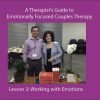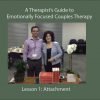Why Do We Become Resentful?
In a relationship it is very easy to step on your partner’s toes. We are always making interpretations of each other’s actions and omissions, statements, and silences.
The moment a negative interpretation creeps into the relationship, it will provoke a feeling in the perceiving partner, which will need to be dealt with somehow.
When things are fine in a relationship, the partner may feel safe and comfortable enough to talk about their interpretation and to share the feeling it provoked.
But sometimes when this does not happen, negative interpretations are left to fester and may instead turn into a subtle change in behavior, which gets passed back to the other person and leads to a negative interpretation and feeling in them. Over time this might lead to the build-up of resentments toward each other.
Why John and Mary Started to Resent Each Other:
John and Mary are a married couple who often found themselves making negative interpretations of each other's actions. Small situations could lead to big consequences, such as long periods of silence and disconnection, or protracted periods of anger and hostility.
One evening, John felt hurt by Mary’s subtle body movement away from him when he tried to rub her shoulders. He interpreted this as a sign of rejection, which produced a feeling in him of hurt. Because John, however, felt silly about being so impacted by his wife and felt too vulnerable to let her in on how much her approval matters to him, he was unable to share how he really felt.
Instead he channeled his feelings into the more acceptable response of becoming emotionally distant, and he all of a sudden became very quiet and withdrawn.
Mary, of course, picked up on the change in his behavior and interpreted it as a sign that John was angry with her. This interpretation made her feel annoyed because she generally thinks John has a tendency to be easily offended and to withdraw emotionally as a form of punishment.
Mary resented that John can shut her out that easily, but she was not in touch with the sadness and pain underneath this resentment. Therefore, when John eventually wanted to breach the gap of disconnection by showing physical affection again, Mary was not ready to accept his peace gesture, but brushed him off in a similar way that he had felt brushed off when he tried to rub her back to begin with.
This interaction between John and Mary is a perfect example of how couples get into trouble by not talking about how they truly feel. Because both John and Mary are only in touch with their anger at each other, they end up passing negative emotions back and forth and perpetuating a negative way of relating to each other.
The Danger of Not Talking about Your Feelings:
Over time, negative emotions can build up and make each partner harden themselves and become less and less vulnerable. What could have become an opportunity to know something about the deeper feelings and needs of each other instead becomes the source of built up resentments.
When we are both not getting what we are needing from each other, but find it difficult to talk about this with each other, the normal response is to become increasingly angry, or to begin to withdraw emotionally to lick one’s own wounds and protect oneself from further disappointment.
The emotional bond is still there, but it becomes hidden by resentments about not feeling loved and not feeling appreciated, or not feeling that your partner has your back or can be counted on. What we want so much from each other becomes too risky to let each other in on, and becomes buried underneath arguments which make it seem like we are not loved, and that what we ultimately want and long for is out of reach.
How to Get Out of a Pattern of Resentment:
In order to shift out of the negative dance that has developed over time, both partners need to get in touch with what they are really feeling underneath their need to protect themselves or their anger at their partner for not seeming to care.
In order to do this, both you and your partner, need to understand that underneath anger or indifference, often lie needs, longings, and more vulnerable emotions. These needs, longings, and feelings may have been buried for so long that they are not really present in your conscious awareness, so you might need to do a little digging to uncover them.
To help you out you can try an easy little exercise that will help you access your true feelings about some recent situation that bothered you. The goal is to help you turn resentments into opportunities for closeness and understanding:
5 Steps to Turning Resentments into Greater Closeness:
- Identify the trigger of your negative emotion: Try to identify the situations that has bothered you or have made you feel some negative emotion. Try to be as specific as possible about what triggered this emotion. Mary, for example, could point out that she has a negative emotional reaction when John shuts her out emotionally. This trigger, however, is still rather general, and could become even clearer if Mary was able to identify that when “you shut me out yesterday because I didn’t feel like getting my back rubbed, I had a negative reaction"
- Identify the immediate emotional reaction to the trigger: What was the immediate emotional reaction you were most in touch with in the situation you identified as bothersome? Did you feel angry? Did you feel self-protective, such as frozen, numb, or detached? Mary, for example, was able to identify that John’s detachment or sullenness filled her with anger at him for shutting her out.
- Identify behavioral reaction to emotion: How did the emotional reaction you were most in touch with make you act? Did you withdraw? Did you lash out? Did you leave the room? Mary, for example, was able to identify that when she felt shut out for refusing the back rub, she reacted to the anger she felt, by brushing off John’s later attempt to reconnect as a kind of “tit for tat”
So far, so good: we have now identified the sequence of events that motivated Mary’s actions, but we have still only stayed at the surface. The next part of the exercise asks you to dig a little deeper to get to the real heart of the matter:
- Identify deeper feelings triggered by the situation: Underneath our anger or our indifference and numbness, we often hide the more tender feelings of fear, shame, or sadness. Ask yourself the question: what did I feel just before I got angry? Or: What did I feel just before I shut down? Did your feelings get hurt? If so, why? What is your anger or indifference masking about how you really feel? In Mary’s case, her anger was really masking her hurt feelings. When she dug a little deeper, she was able to acknowledge to herself, that when John seemed to shut her out, it was very unpleasant and painful for her. It made her feel discarded and rejected, like she wasn’t loved or cared about, or wasn’t good enough. This in turn made her feel sad and somewhat anxious that John might not really accept her for who she is.
- Identify underlying need: Along with the more tender and hurt feelings, we often have certain unmet longings or needs, which these feelings reveal to us. In Mary’s situation, her sadness revealed a need to be important to John and a need to feel secure in the fact that John loves her even when he may not be pleased with something she says or does. More specifically, she would like for John to not just shut her out, but to let her know when he feels hurt, so she does not just feel discarded.
In a similar way John might discover that he shut down (3) when Mary turned away from him (1) because it made him feel rejected and unloved (4), which he in turn felt ashamed to say (4), so instead he got angry (2). He was therefore unable to communicate his need for Mary's approval and affection (5) which he could have expressed as a more specific request to receive a verbal reassurance that Mary still cares about him and still feels attracted to him even though she may not be in the mood for physical intimacy.
Improve Communication in Your Relationship:
Like John and Mary, you too can develop your ability to identify and have conversations about your true feelings.
If you go through these five steps any time you find yourself frustrated, angry, or hurt, and are able to go to your partner and let him or her in on point 4 and 5, you will have mastered the skill to turn resentments and hostility into windows of opportunity for greater closeness and intimacy.
Remember, it is inevitable that you and your partner will step on each other’s toes and hurt each other’s feelings from time to time. What determines if this hurt turns into resentment is whether or not you are able to talk about your hurt feelings. The five-step exercise to turn resentment into greater closeness, is one way to prevent hurt feelings from going underground, and to use miscommunications as means to strengthen the emotional bond between you.
About me: I am Rune Moelbak, Ph.D., couples therapist in Houston Texas. I provide couples therapy and marriage counseling, and help couples turn hostility and anger into opportunities for greater closeness. Visit my website to read more about my approach to couples counseling.

























